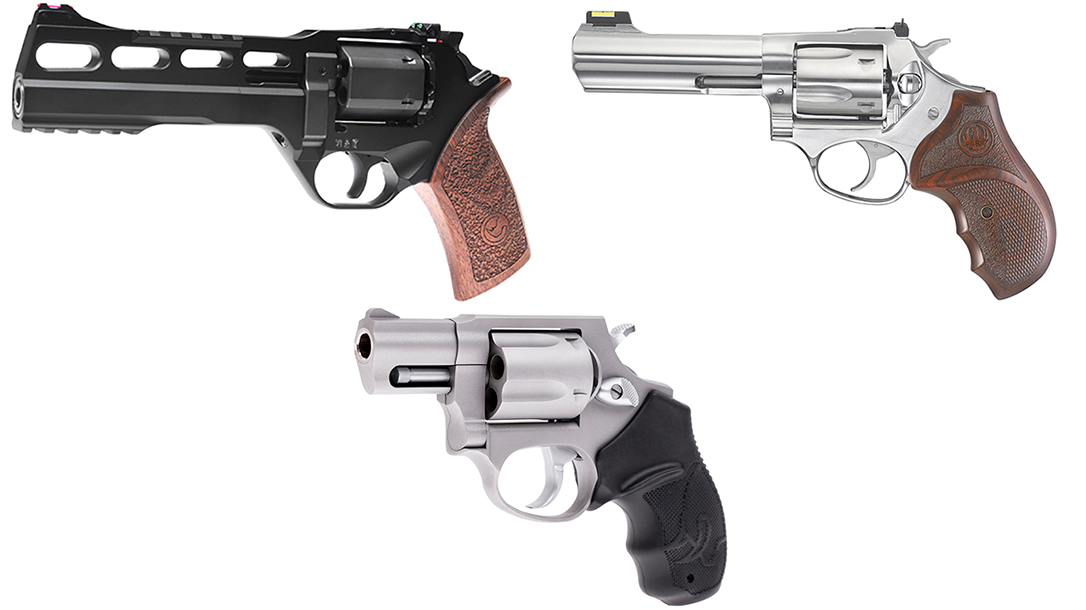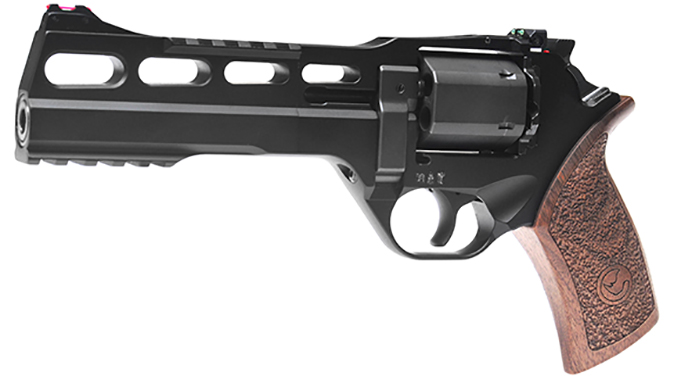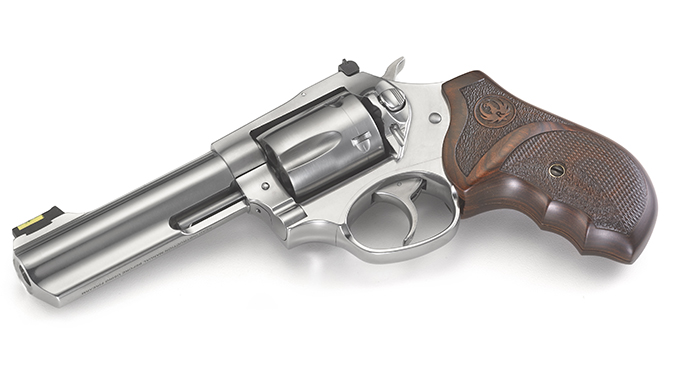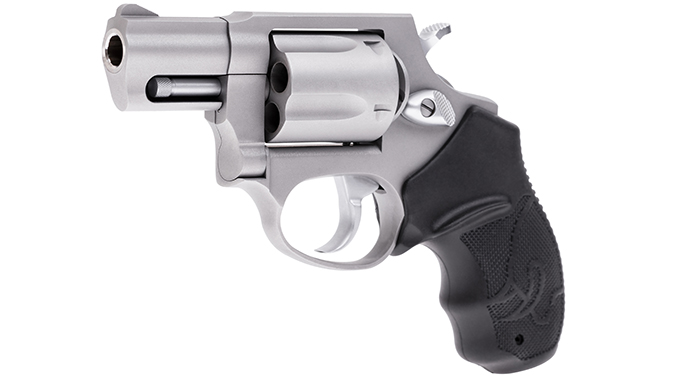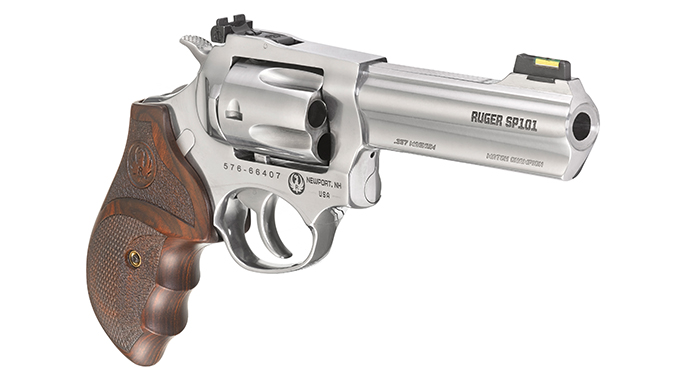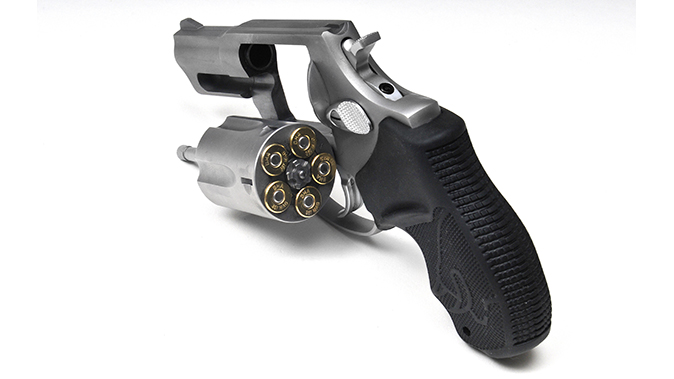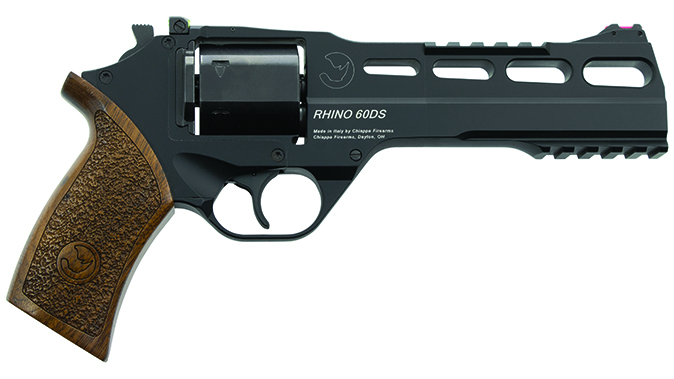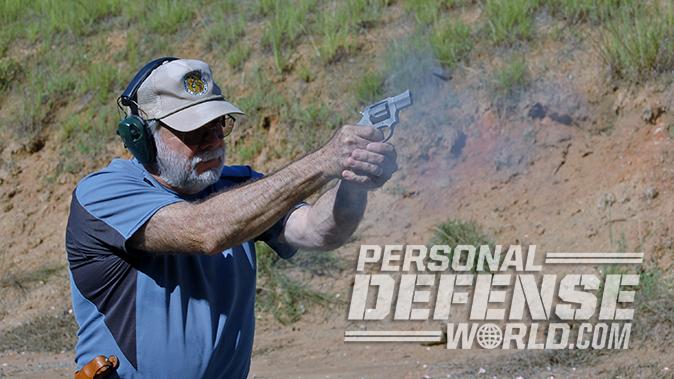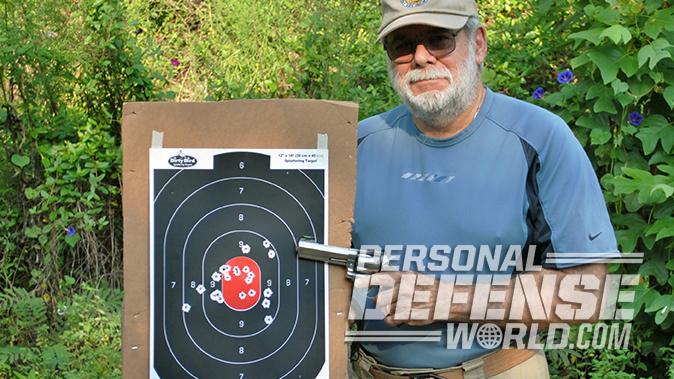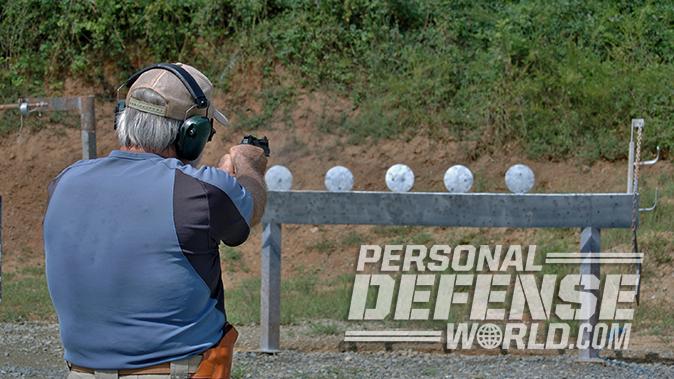What is the most effective defensive handgun cartridge? Many 1911 fans might claim the .45 ACP, while others, especially those in law enforcement, would no doubt champion the .40 S&W. A third group would put the new high-performance 9mm loads at the top of the list. But they would all be wrong. The fact is that the most effective defensive handgun cartridge was introduced 82 years ago—in a revolver! What am I talking about? Why, the Smith & Wesson .357 Magnum revolver of course.
Birth Of A Legend
In the mid-1930s, Smith & Wesson Vice President Douglas B. Wesson set in motion a program to develop a revolver cartridge that outperformed the competition. S&W and Winchester did so by simply lengthening the .38 Special case by 0.125 inches, allowing it to contain a larger charge of propellant. The original S&W .357 Magnum propelled a 158-grain lead bullet to 1,515 fps for 780 foot-pounds of energy (fpe).
Advertisement — Continue Reading Below
By the 1950s, .357 Magnum revolvers like the S&W Model 28 and Colt Trooper had become favorites with police. But smaller and lighter .357 magnum revolver models like the S&W Model 19/66 and Ruger’s Security-Six soon displaced them. They would remain the choice of many knowledgeable law enforcement officers, armed professionals and serious civilian shooters who wanted a “fight-stopping” handgun.
Today, if you peruse the websites of most handgun manufacturers, you will see a plethora of .357 Magnum wheelguns. In this report, I’m going to examine a trio of them that run the gamut in size from the traditional snubbie to one of the most unique-looking revolvers to ever come down the pike.
Taurus Snubbie
In 1985, Taurus introduced its Model 85 revolver, a five-shot snubbie designed for concealed carry by licensed civilians and as a backup or off-duty gun for police officers. Today, the family includes blued steel, stainless steel and “Ultralite” variants chambered for the .38 Special, .357 Magnum, 9mm and .380 ACP.
Advertisement — Continue Reading Below
Taurus sent me a .357 Magnum Model 605 to evaluate. This is an all-stainless-steel gun with a matte finish and a 2-inch barrel with a full-length underlug that protects the ejector rod and adds a bit of recoil-dampening weight up front. The cylinder is locked via a spring-loaded center pin in the ejector rod entering a recess in the recoil plate while a spring-loaded stud on top of the cylinder crane engages a mortise in the frame.
Pushing the thumb latch on the left side of the frame forward allows the cylinder to be swung out to the left. Pushing the ejector rod in forces out a star-shaped extractor, which extracts all of the cartridge cases. The ejector rod is longer than those of many snubbie revolvers and extracts the long .357 Magnum cases completely.
The sights are easy to pick up and align. A serrated front sight mates with a square notch in the topstrap of the frame. These sights cannot be knocked out of zero without massive structural damage to the frame itself.
Advertisement — Continue Reading Below
A transfer bar ignition system is used here. When the trigger is pulled through a complete stroke, a flat bar rises in front of the firing pin, and this is what the falling hammer strikes, driving the frame-mounted firing pin forward to ignite the cartridge. At all other times, the hammer rests on the frame and cannot impact the firing pin.
The gun I received had a stage-free, double- action (DA) stroke that broke with a little more than 9 pounds of pressure, while the single-action (SA) pull broke crisply at 4.5 pounds. The finger-grooved rubber grips provided a firm purchase, even with sweaty or oily hands, and helped tame the rather snappy recoil of the .357 Magnum rounds.
Ruger’s Champion
The newest addition to Ruger’s line of revolvers uses the small SP101 frame, but it comes with a number of features more often associated with larger revolvers. Like the other revolvers under discussion here, the SP101 Match Champion is chambered for the .357 Magnum cartridge, which means shooters can also fire .38 Special ammo.
Advertisement — Continue Reading Below
Made from stainless steel, the revolver’s 4.2-inch barrel provides a longer sight radius, and the full-length underlug protects the ejector rod and adds a bit of weight up front to help soak up recoil. A green fiber-optic front sight mates with a fully adjustable rear for a bright, sharp sight picture that is just the ticket for fast, accurate shooting, especially in low light.
The cylinder is locked by a center pin on the end of the ejector rod engaging a recess in the recoil plate, a latch on the cylinder crane engaging a cutout in the frame under the ejector rod housing and a bolt in the bottom of the frame engaging notches in the cylinder. The five-round cylinder is opened by pushing the release in, which allows you to swing the cylinder out for loading and unloading. And like the Taurus Model 605, the Ruger uses a transfer bar ignition system.
The one-piece Altamont hardwood grip, with its stippled and checkered sides, is not only extremely attractive, but also provides a secure purchase for enhanced recoil control, especially when firing .357 Magnums rounds. Removing a single screw allows the grip to be changed.
Advertisement — Continue Reading Below
Despite its name, I think of the Match Champion more as a trail gun on steroids. When the “problem” one might encounter far from civilization is a coyote, a rabid feral dog, a wild pig or a predatory human, I would want a handgun with more “oomph” than a .22 rimfire. Compact, rugged, easy to maintain and firing the .357 Magnum, the SP101 Match Champion fills the bill to perfection.
The Charging Chiappa
When traditionalists first saw the Chiappa Rhino 60DS revolver, I’m sure they all got a severe case of the vapors. This is because the Rhino’s construction and method of operation are unlike any other wheelgun out there.
The Rhino’s cylinder has a hexagonal shape, which reduces the revolver’s width considerably. But its most unique feature is that it fires from the bottom of the cylinder rather than the top, lowering the bore axis almost to the palm of the shooter’s hand, greatly reducing muzzle flip and felt recoil.
Advertisement — Continue Reading Below
The frame and integral barrel shroud are made from aluminum alloy, the cylinder and barrel are stainless steel, and there is a steel insert on the recoil shield. An accessory rail on the bottom of the barrel shroud allows you to mount a light or laser while the 60DS also comes with a short rail on top for an optic.
Pivoting a catch on the left-rear side of the frame allows the cylinder to be swung out to the left. Pushing on the ejector rod simultaneously extracts and ejects all six cartridge cases. The rear of the Rhino’s cylinder has been machined to accept full-moon clips, and several are supplied with the revolver. These allow faster reloading and positive ejection of all six spent cases.
Advertisement — Continue Reading Below
The Rhino’s firing mechanism features a fully enclosed hammer inside the frame. For SA firing, the Rhino is fitted with a cocking lever (or “false hammer”) at the rear of the frame. This cocking lever is connected to the concealed hammer via a push link. To cock the gun for SA firing, the shooter pulls the cocking lever back as far as it will go, then releases it. This movement will cock the concealed hammer via an internal linkage, but the cocking piece will return to the forward position once it is released. For DA firing, pulling the trigger cocks the internal hammer and releases it at the end of the trigger stroke. When the hammer is cocked, a red pin left of the cocking lever rises up, providing a visual indication of the gun’s condition.
As with our other two test guns, cylinder locking is accomplished by the center pin on the end of the ejector rod engaging a recess in the recoil plate while a spring-loaded stud in the frame engages a depression on the top of the cylinder crane.
While odd looking, the Rhino’s grips provide a firm purchase and good recoil control. The front sight has a red fiber-optic insert while the adjustable rear sight has dual green fiber-optic inserts. All three are very bright, providing for fast target acquisitions.
Advertisement — Continue Reading Below
Trio Testing
The .357 magnum revolver models were test-fired at 10 (Taurus), 15 (Ruger) and 25 (Chiappa) yards from a MTM K-Zone rest with both .357 Magnum and .38 Special ammunition. With their preferred loads, all three proved capable of producing sub-2-inch groups, with honors going to the Chiappa for a perfectly centered group measuring just 1 inch in size with the Winchester .38 Special ammo.
We then ran the Taurus and Ruger through a series of off-hand drills on a combat target from 7 yards. While both their triggers displayed the usual “new gun” stiffness, the trigger strokes were stage-free and, except for one round from the Ruger that wandered out into the 8 ring, all of the .38s impacted inside the 9 and 10 rings.
To see how our Italian entry performed, we moved over to the steel range and spent a half hour running plate racks with it. It took me and my friend a while to get the measure of the oddly shaped grip and grip-to-frame angle, but thanks to its smooth, short DA trigger and fiber-optic sights, we were soon going six for six.
After running in excess of 400 rounds through our trio of .357 magnum revolvers, I can attest that they’re all suitable to their intended purposes. If you need a small, lightweight .357 for concealed carry, you need look no further than the Taurus Model 605. While the Ruger will also do quite well for CCW, I feel its natural role in life would be as a powerful but portable trail gun capable of handling just about anything smaller than a bear in the wild.
Lastly, I feel the untraditional Chiappa Rhino 60DS would be an excellent choice for competition (especially with a reflex sight installed) or hunting medium-sized game such as whitetail deer or wild pigs.
So it’s my contention that, despite coming up on its 82nd birthday, the .357 Magnum revolver is still capable of handling any task you might put it to. And handling it damn well in the bargain!
357 Magnum Revolver Spectrum
| Manufacturer | Chiappa Rhino 60DS | Ruger SP101 Match Champion | Taurus Model 605 |
|---|---|---|---|
| Caliber | .357 Magnum/.38 Special | .357 Magnum/.38 Special | .357 Magnum/.38 Special |
| Barrel | 6 inches | 4.2 inches | 2 inches |
| OA Length | 10.5 inches | 9.12 inches | 6.5 inches |
| Weight | 32.96 ounces (empty) | 30 ounces (empty) | 24 ounces (empty) |
| Grip | Walnut | Altamont hardwood | Rubber |
| Sights | Fiber-optic front, adjustable rear | Fiber-optic front, adjustable rear | Fixed |
| Action | DA/SA | DA/SA | DA/SA |
| Finish | Matte black | Stainless | Stainless |
| Capacity | 6 | 5 | 5 |
| MSRP | $1,229 | $859 | $389 |
Chiappa Rhino 60DS Performance
| Load | Velocity | Accuracy |
|---|---|---|
| Black Hills 125 JHP (.357 Magnum) | 1,478 | 2.50 (Average), 2.00 (Best) |
| Federal 158 JSP (.357 Magnum) | 1,222 | 2.30 (Average), 1.80 (Best) |
| Sig Sauer 125 FMJ (.38 Special) | 893 | 2.50 (Average), 1.50 (Best) |
| Winchester 158 LSWC (.38 Special) | 792 | 2.30 (Average), 1.00 (Best) |
*Bullet weight measured in grains. Velocity measured in fps by chronograph. Accuracy measured in inches for three 5-shot groups at 25 yards.
Ruger SP101 Match Champion Performance
| Load | Velocity | Accuracy |
|---|---|---|
| Black Hills 125 JHP (.357 Magnum) | 1,396 | 2.80 (Average), 2.10 (Best) |
| Federal 158 JSP (.357 Magnum) | 1,208 | 3.30 (Average), 1.80 (Best) |
| Sig Sauer 125 FMJ (.38 Special) | 867 | 2.30 (Average), 1.60 (Best) |
| Winchester 158 LSWC (.38 Special) | 744 | 3.00 (Average), 1.50 (Best) |
*Bullet weight measured in grains. Velocity measured in fps by chronograph. Accuracy measured in inches for three 5-shot groups at 15 yards.
Taurus Model 605 Performance
| Load | Velocity | Accuracy |
|---|---|---|
| Black Hills 125 JHP (.357 Magnum) | 1,273 | 3.00 (Average), 2.30 (Best) |
| Federal 158 JSP (.357 Magnum) | 1,132 | 3.30 (Average), 2.00 (Best) |
| Sig Sauer 125 FMJ (.38 Special) | 803 | 2.80 (Average), 1.80 (Best) |
| Winchester 158 LSWC (.38 Special) | 677 | 2.80 (Average), 200 (Best) |
*Bullet weight measured in grains. Velocity measured in fps by chronograph. Accuracy measured in inches for three 5-shot groups at 10 yards.
For More Information
Chiappa Rhino 60DS
chiappafirearms.com
Ruger SP101 Match Champion
ruger.com
This article is from the January/February 2018 issue of “Combat Handguns” magazine. To order a copy and subscribe, visit outdoorgroupstore.com.
